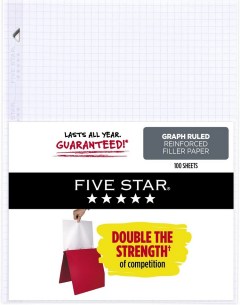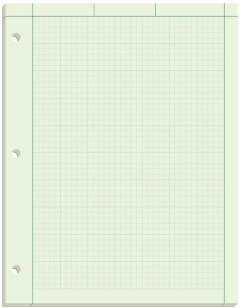BestReviews is reader-supported and may earn an affiliate commission. Details

Graph paper that resists pulls, tears, and snags out of binders.
Standard-sized graph paper with 3-hole punch to easily put into binders. Made with stronger reinforcement tape to resist tearing. Holes are a more durable, patent pending triangle shape. These types of holes also make turning pages easier.
Boxes on front of sheets are bigger than on the back of sheets.

Budget-friendly pads that are great for technical drawing and sharing.
Comes with two pads of 100-sheet graph paper. Pad features chipboard backing for writing support. Top-edge perforation for clean and easy tearing. Sheets can be used on both sides.
Paper is thin and is best when used with a pencil or ballpoint pen.

A mega pack of graph paper for filling binders.
Pack includes 400 sheets of graph paper with 3-hole punches to fit in standard binders. Graph paper has subtle lines to provide guidance without getting in the way of writing or drawing. Accommodates pencils, ink, and gel pens.
Paper is not strong enough to hold after lots of erasing.

Simple, sturdy graph paper that's thicker than most.
Paper is 1.5 times thicker than other graph papers. The 4 x 4 graph paper is ideal for note taking. Thick paper prevents bleed and can be used on each side. Cardboard back for writing support. Paper is perforated at the top.
Grid lines are dark and noticeable.

Green-tinted graph paper is great for professional use.
Has 100 sheets of 5 x 5 cross-section ruling. Pages have wide margins so hole punches don't interfere with graph area, making for easy, standardized formatting. Green tint helps reduce eye strain and fatigue.
Paper is one-sided with grid lines on the back (which can be seen on the front side).

We recommend these products based on an intensive research process that's designed to cut through the noise and find the top products in this space. Guided by experts, we spend hours looking into the factors that matter, to bring you these selections.

Most people remember graph paper from math classes in school. These sheets with their familiar grid might spark memories of happiness or terror, depending on how you feel about the subject. However, many of us never use this paper once we’re out of school. But graph paper is so much more useful than just a bygone school necessity.
Engineers and architects regularly use graph paper in their projects. Crafters, quilters, and sewing enthusiasts use graph paper for sketching and designing patterns. Interior designers use it to create floor plans, and graphic designers use it for layouts. Artists use graph paper for drawings and illustrations, especially where proportion and perspective are important. Sometimes just filling in the squares on graph paper can be a calming mindfulness activity. And there are many people who enjoy using graph paper for writing.
There are several types of graph paper available. Whether you need it for school, work, or fun, there’s a type out there for you. A good shopping guide and recommendations can help narrow your choices.

Choosing the right graph paper for you comes down to deciding what you need it for. It might surprise you to know that there are many different types, and each one is designed for different uses.
Quad: Quad-ruled, quadrille, or quad paper is the most common kind of graph paper, the kind you probably used in school. It has a regular grid of squares printed on a sheet of paper. It comes with different grid sizes.
Engineering: You can find this type of graph paper, designed for use by engineers and architects, at office supply stores. It differs from quad paper by having a blank margin and a pale greenish tinge. And the grid, printed on the back, shows through the translucent paper. It usually also has a title field and a finer grid. Some students prefer to use engineering paper rather than standard quad paper because it gives their work a more polished look.
Millimeter: This paper has a very fine grid of ten squares per millimeter. It’s useful for making technical drawings, but it can also be used to design intricate patterns of any kind, including and especially in stitching, embroidery, and other needle arts.
Logarithmic: The grid on this paper is printed with the logarithmic scale. This allows you to plot logarithmic data more quickly and easily than on a standard linear grid. Logarithmic paper comes in semi-log and log-log versions, with one or both axes displaying the logarithmic scale.
Hexagonal: Instead of a rectilinear grid, this paper has a grid composed of hexagons. You might want to use hexagonal graph paper if you’re working with chemistry, but it’s also useful for designing, 3D modeling, mapping, crafting, and quilting.
Normal probability: This is a special type of graph paper that can help you determine if a data set follows the rules of a normal distribution pattern.
Polar coordinate: This paper has regularly spaced concentric circles emanating from or converging on a point. It’s used for math and engineering data, navigation, and mapping.
Isometric: This paper has a grid of triangles or chevrons with 60° angles. This paper is used for drawing three-dimensional illustrations and isometric projections. It’s useful in engineering and architecture, and it has fun and artistic applications too.
A dark-colored grid can make it harder to see or read your notes, especially if you use a light-colored pencil.
The most important feature of graph paper of any type is the grid. There are several grid sizes available. Here are some that are widely available:
Perhaps an overlooked feature of graph paper is color: the color of the grid lines and the color of the paper itself.
Quad graph paper usually has a blue or green grid on white paper. Some has a black or gray grid. And some paper has lines of different weights or colors to differentiate between various blocks of squares and improve legibility.
Some paper has a grid defined by dots or dashes rather than solid lines.
Engineering paper comes in specific shades of green that are easy on the eyes and a grid that disappears when scanned or photocopied, showing only the written graphs and notes.
Like all paper, graph paper comes in different weights that reflect how thick it is. Weight influences the paper’s durability, transparency, and ability to stand up to ink and pencil marks. The most common weight of office paper is 20 pounds, and 20-pound graph paper is an excellent all-around paper for daily use. Heavier paper prevents ink from bleeding through; lighter paper can be more translucent.
You can buy graph paper in loose sheets or bound in tablets or notebooks. If you expect to eventually store your loose-leaf paper in a binder, look for graph paper with reinforced, pre-punched binder holes and a binding margin. If you buy graph paper already bound in tablets or notebooks, it’s useful to choose paper with perforations that make it easy to cleanly tear out individual sheets.

Three-ring binders used to be required school supplies for students, and they’re still a practical place to store and organize paper. Many types of graph paper come pre-punched for storing in a three-ring binder.
A mechanical pencil with its thin, precise lead is an ideal tool for writing on graph paper. It’s excellent for drawing points and lines, as well as neatly writing numerals and sketching diagrams.
A ruler is helpful not just for drawing straight lines but also for scaling and measuring, for example, when creating a floor plan or transferring data to and from a map. A protractor helps you draw and measure angles on a graph or vectors on polar coordinate paper.
If your graph paper doesn’t have pre-punched holes, a manual or electric hole punch is useful if you want to store your paper in a binder.
The least expensive graph paper is free. You can find downloadable templates available online from schools, colleges, and other sources. These templates fit letter- or legal-size paper. Some templates have different colors of grid, or you might be able to change the color yourself. These free templates are handy if you don’t need to use graph paper often. If you use it often and need paper of a particular weight or color, you might have to buy it.
Packs, blocks, and reams of graph paper commonly cost less than $10 for 100 sheets. These include writing pads and tablets, packs of unpunched or pre-punched sheets, and notebooks.
Heavier-weight or higher-quality graph paper costs more than $10 for 100 sheets. High-end journals with grid paper cost from $15 to $25, while top engineering, logarithmic, and isometric paper can cost more than $20 per pack.
You can also find pens with graph paper designs, graph paper wallpaper, and graph paper bedding.

A. Yes. Aside from downloading and printing templates, you can create a grid using software. Some graphic design and drawing software comes with an automated grid tool. You can also use spreadsheet software like Excel to print a grid of cells.
A. You can make graph paper either by adding perpendicular lines to lined notebook paper or drawing a grid on blank paper. Either way, make sure you use a ruler not just to draw straight lines but also to maintain regular spaces between the lines. For lined notebook paper, measure the space between the existing lines and duplicate that width when drawing your grid. For blank paper, establish your scale with your ruler, mark it along the length and width of the paper, then draw the lines according to those marks.
A. While graph paper is often thought of as specifically used for math and other specialized functions, many people find it just as appealing for taking notes. Dot grid or dashed paper can be an especially versatile choice for writing because it has all the benefits of note paper plus the organizing features of a grid. Some people just like the novelty of writing on graph paper as well.
Get emails you’ll love.
Learn about the products you’re wondering if you should buy and get advice on using your latest purchases.
